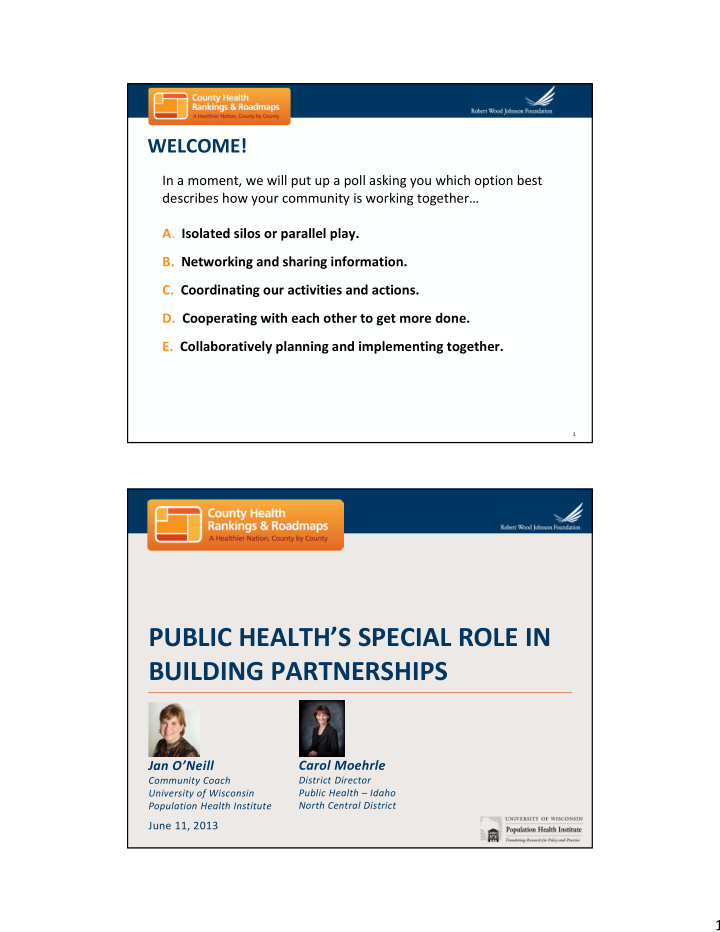



WELCOME! In a moment, we will put up a poll asking you which option best describes how your community is working together… A . Isolated silos or parallel play. B. Networking and sharing information. C. Coordinating our activities and actions. D. Cooperating with each other to get more done. E. Collaboratively planning and implementing together. 1 PUBLIC HEALTH’S SPECIAL ROLE IN BUILDING PARTNERSHIPS Jan O’Neill Carol Moehrle Community Coach District Director Public Health – Idaho University of Wisconsin North Central District Population Health Institute June 11, 2013 1
ACKNOWLEDGEMENTS ‣ Robert Wood Johnson Foundation – Including Abbey Cofsky, Paul Kuehnert, Michelle Larkin, Jim Marks, Joe Marx, Naima Wong ‣ Wisconsin County Health Rankings & Roadmaps Team – Including Bridget Catlin, Julie Willems Van Dijk, Patrick Remington, David Kindig, Angela Russell, Amanda Jovaag, Alison Bergum ‣ Our Partners – Including Burness Communications, Community Catalyst, United Way Worldwide, ASTHO, NACCHO, NNPHI, Dartmouth Institute, CDC, NCHS 3 GO TO WEBINAR ATTENDEE INTERFACE 1. Viewer Window 2. Control Panel 4 2
OUTLINE ‣ County Health Rankings & Roadmaps Overview ‣ The Changing Role of Public Health ‣ Q & A ‣ Roadmaps to Health Action Center Tool ‣ Summary & Wrap Up 5 ESSENTIAL QUESTION What is the new role of public health, and why is it so important that this new role be played today? 7 3
8 COUNTY HEALTH RANKINGS : 2 RANKINGS Health Health Factors Outcomes Today’s Tomorrow’s Health Health 9 4
10 www.countyhealthrankings.org 11 5
12 13 6
Carol Moehrle District Director Public Health – Idaho North Central District 14 THIS IS IDAHO 15 7
IDAHO’S PUBLIC HEALTH STRUCTURE ‣ 7 Districts sit at one table ‣ Local control and oversight ‣ Statewide LHD strategic plan ‣ Timely consideration of local health issues ‣ Working on Accreditation ‣ Local policy making boards preparations address needs and ‣ Project Public Health Ready coordinate delivery of ‣ Regional Response services 16 PUBLIC HEALTH EFFICIENCIES ‣ Shared resources ‣ Sustain our past successes ‣ Confront our emerging challenges ‣ Use our available resources most efficiently and effectively 17 8
THREAT OR OPPORTUNITY? 18 CURRENT OPPORTUNITIES IN PUBLIC HEALTH ‣ Public Health valued as a convener ‣ Be more flexible in practice and partnerships ‣ What can we leverage to improve population health? 19 9
PARTNERS WORKING TOGETHER 20 TRADITIONAL PARTNERSHIPS ‣ Elected officials, State and Local ‣ Peers in Public Health ‣ Boards of Health ‣ Education ‣ Worksites ‣ Businesses ‣ Medical community 21 10
The Public Health Partners Hom e Com m unity Police MCOs Churches Health Centers Health Departm ent Corrections EMS Parks Elected Hospitals Mass Transit Doctors Schools Officials Nursing Philanthropist Hom es Environm ental Health CHCs Fire Civic Tribal Groups Laboratory Health Drug Econom ic Em ployers Facilities Treatm ent Developm ent Mental Health 22 WORKING WITH PARTNERS IN IDAHO Local Public Health works with a wide range of community partners to create conditions and policies that help people be healthy – Tobacco Free Alliance – Collaboration with Hospitals for CHA/CHIP – Regional Solid Waste advisory group – Diabetes partnerships – Regional Health Care Network 23 11
ADVANTAGES OF POLICY & ENVIRONMENTAL CHANGE TO ADDRESS PUBLIC HEALTH ISSUES ‣ Potential for systemic change in a community or environment. ‣ Policy ‐ based strategies have proven very effective in major public health battles. (e.g., tobacco control movement) ‣ Broad Reach: Opportunity to “level the playing field” for all members of a community, including disproportionately impacted populations. ‣ Flexibility: Consider the unique characteristics and needs of your community and implement prevention initiatives to address them. 24 ESSENTIAL ELEMENTS OF SUCCESSFUL AND SUSTAINABLE LOCAL COALITIONS ‣ Engaged Stakeholders and Volunteers ‣ Visibility ‣ Capacity ‣ Strategic Planning ‣ Data ‣ Leadership ‣ Cross ‐ Coalition Collaboration 25 12
26 27 13
FACTORS THAT HINDER LOCAL COALITION FUNCTIONING ‣ Lack of capacity ‣ Lack of engagement ‣ Lack of community support ‣ Strategic planning issues ‣ Inability to maintain momentum 28 CALL TO ACTION ‣ What can local governments do right now? – Enact policy and environmental initiatives that support healthy communities. – Partner with a variety of local agencies to leverage resources and achieve greater impact – Set feasible short and long term goals to address the unique needs of your community – Measure your community’s performance and adjust goals as necessary 29 14
30 TIMING IS EVERYTHING 31 15
QUESTIONS 32 www.countyhealthrankings.org/roadmaps 33 16
34 2013 WEBINAR SERIES Breaking Down the Partnership Series Take Action Series Rankings Model Series Register for upcoming webinars and find recordings at www.countyhealthrankings.org/webinars 35 17
ESSENTIAL QUESTION What is the new role of public health, and why is it so important that this new role be played today? 36 CONTACT INFORMATION Karen Odegaard Jan O’Neill Kate Konkle karen.odegaard@match.wisc.edu jan.oneill@match.wisc.edu kate.konkle@match.wisc.edu Phone: 608.265.6486 Phone: 608.265.6694 Phone: 608.265.5395 37 18
STAYING CONNECTED e ‐ Newsletter: chr@match.wisc.edu 38 “Change brings opportunity.” ‐ Nido Qubein 39 19
Recommend
More recommend